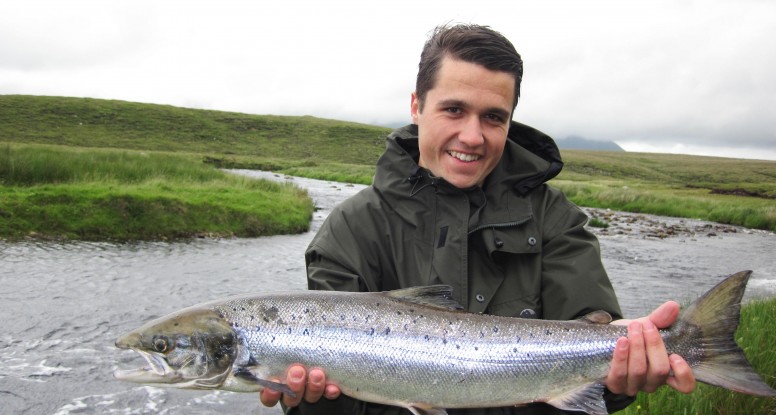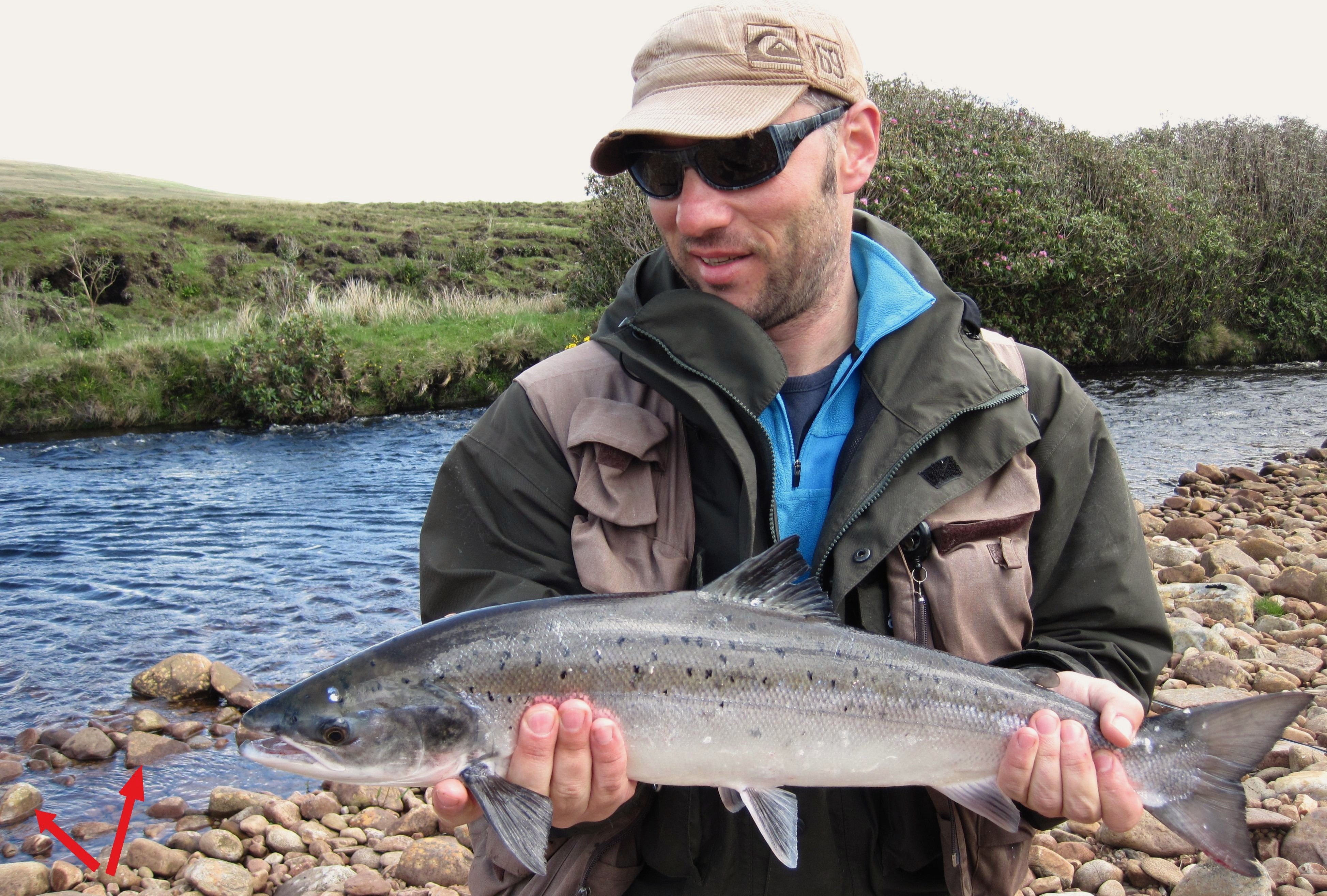
Salmon Lies (Part 3)
SALMON LIES (Part 3)
In part one we looked at why a salmon might chose to lie at a particular place in a river. The main requirements of a good lie at normal water levels as far as the salmon is concerned are, an evenly flowing steady current that allows the fish to minimize its expenditure of energy, the required depth of water so the salmons natural camouflage is effective, and that the rate of current flow provides just the right amount of oxygen. There is a trade off between the comfort level of any given lie and the oxygen availability its current flow rate provides to the salmon. The amount of oxygen that salmon require varies with their level of activity and when we factor in the changes in the dissolved oxygen content of water that occurs as it warms up we realise why it is sometimes difficult to precisely pinpoint salmon lies. During periods of moderate air and water temperature all the salmon has to do to regulate its intake of oxygen is to move slightly into or out of the flow. If the required slight movement to regulate oxygen intake happens to be into a stronger flow then this is where the trade off is decided. When the extra energy needed to stay in the slightly stronger flow is not excessive, or the period of time spent there is likely to be short then the fish maybe content to stay in its lie. Sometimes it just takes too much energy for the fish to access the required oxygen and it is forced to seek out a more suitable lie where this fine balance between energy conservation and oxygen intake is once again restored. This movement of resident salmon within pools to regulate their oxygen intake should be a very important factor to take into consideration in our overall analysis of potential lies in any salmon pool. An example of this is when there maybe an oversupply of oxygen, then all a salmon has to do in this situation is find a nice gentle flow to match its respiration rate. It is no wonder that the competent anglers of past generations often targeted early spring salmon in the slower deeper sections of pools.
All these variables of water height, water clarity, water depth, water temperature, time of year, time of day, various other weather conditions, oxygen content of the water, type of river, can be an overload of data for the beginner salmon angler to have to contend with all at once, so let us try and look at things as simply as possible from a few different perspectives. The first thing we might try to confirm is the actual water level and whether it is rising, falling, or holding steady.

Try to get in the habit of viewing new pools from downstream as they will reveal all their various nuances of current deflection much better from this vantage point.

If you are a newcomer to the river and are not sure whether the water level is low, medium or high, then this photo might help. The water is at grass level and there are no small rocks or shingle showing. It would be a fairly accurate guess that the water level of the river in this situation is high.

When the shingle banks start to show prominently we can then start to say the river is running at a medium flow or level

This angler is fishing in low water; in fact he has been able to walk three quarter way across the river! The long grass growing on the rock at center river tells us that the river has been low for quiet a while.

In the photo above Jurgen Van den Hout is about to release a grilse that he has caught in low water conditions on the river Owenduff. We can see from all the exposed stones and gravel that the water level is low. The weather is bright and sunny and there is good drying. If we look at the two red arrows pointing at the two small stones we can see by the dark damp look of the bottom two inches(50mm) of these stones that there has been a slight rise in the river level about 1 or 2 hours earlier and the water level has dropped back down again. This is a spate river which rises and falls very quickly and it does not take much rain to bring up its water level a few inches. Experienced salmon anglers will always be watching for visual clues like this but beginners maybe unaware of the critical impact that missing these clues may have on their chances of success. The lessons to be learned from this actual situation is that a small rise in water levels on an already low salmon spate river will bring some resident salmon back into a taking mood, but this taking period may not last very long, so we must concentrate our efforts on only the very best know taking lies in each pool and try to fish as many pools as possible in the limited valuable time available to us.
If we can determine that the river is running high then we can zero in on certain sections of the pools we are about to fish. The areas that we should closely scrutinise are the sections of easier current flow at the sides of the pool, the insides of river bends, areas of the pool that may have been too shallow at medium height, or the tail of the pool. Goran Andersson the famous caster and salmon angler once said at the end of a casting demonstration “When the water is high the salmon come close to me and I don’t need to cast a long line, it has taken fifty years for me to learn this and today I give it to you free!”. If we heed Goran’s advice then it is certain that we will catch more salmon in high water.
With the river running at medium height the salmon start to migrate from the sides of the river and enter the main flow in the middle of the pool. At this height there will be salmon running and we may find them in the head or tail of the pool also. The resident salmon will probably favour the main belly of the pool while any new arrivals could well be located in the tail or neck. Productive salmon lies in medium water height can be difficult to read, but look out for pool tails of sufficient depth immediately above turbulent rapids and pool necks/heads with a nice even flow. In some pools the neck will seem to offer the best lies while in others the belly or tail may be more attractive. The best bet is to concentrate your main effort in the area of the pool where you think that you have spotted some potential lies and then give the rest of the pool a run through.
Good low water pools on any salmon river are a precious commodity, as they must have sufficient depth/flow, and this is something that the majority of other pools lack in these conditions. The middle and tail sections of most pools in low water usually lack any real flow and this causes problems for the salmon such as oxygen accessibility, camouflage/safety. Salmon (especially grilse) will run the river in low water and some low water pool tails are always worth a search, especially early in the morning. We won’t go too far wrong if we concentrate the majority of our effort at the head of the pool in low water.
At the risk of oversimplifying all the variables involved, an abbreviated version of the three previous paragraphs might read like this – In high water salmon will generally move to the edges and tails of pools-In medium water we should take care as we may find a salmon lying in the head, main body, or tail of the pool- In low water the head of the pool is the place to concentrate on, with the tail been worth a cast in the mornings or evenings.

The red arrow points to a salmon lie in a slick evenly flowing pocket of water that is created by the rock (yellow arrow) providing a break in the current flow. As is usually the case, salmon will not lie in the turbulent water immediately behind the rock, but downstream from it where the current starts to flow evenly again.
The most successful salmon anglers on any river system are the ones that have studied and learned how different water levels affect where salmon will lie.
All the best
Paddy
